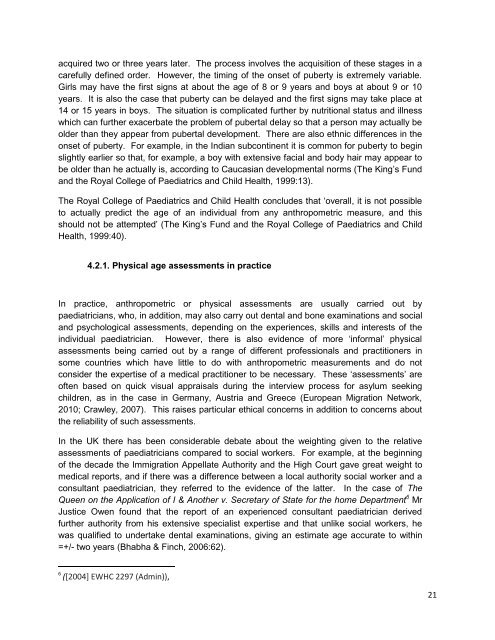Age assessment practices: a literature review & annotated ... - Unicef
Age assessment practices: a literature review & annotated ... - Unicef
Age assessment practices: a literature review & annotated ... - Unicef
Create successful ePaper yourself
Turn your PDF publications into a flip-book with our unique Google optimized e-Paper software.
acquired two or three years later. The process involves the acquisition of these stages in a<br />
carefully defined order. However, the timing of the onset of puberty is extremely variable.<br />
Girls may have the first signs at about the age of 8 or 9 years and boys at about 9 or 10<br />
years. It is also the case that puberty can be delayed and the first signs may take place at<br />
14 or 15 years in boys. The situation is complicated further by nutritional status and illness<br />
which can further exacerbate the problem of pubertal delay so that a person may actually be<br />
older than they appear from pubertal development. There are also ethnic differences in the<br />
onset of puberty. For example, in the Indian subcontinent it is common for puberty to begin<br />
slightly earlier so that, for example, a boy with extensive facial and body hair may appear to<br />
be older than he actually is, according to Caucasian developmental norms (The King‟s Fund<br />
and the Royal College of Paediatrics and Child Health, 1999:13).<br />
The Royal College of Paediatrics and Child Health concludes that „overall, it is not possible<br />
to actually predict the age of an individual from any anthropometric measure, and this<br />
should not be attempted‟ (The King‟s Fund and the Royal College of Paediatrics and Child<br />
Health, 1999:40).<br />
4.2.1. Physical age <strong>assessment</strong>s in practice<br />
In practice, anthropometric or physical <strong>assessment</strong>s are usually carried out by<br />
paediatricians, who, in addition, may also carry out dental and bone examinations and social<br />
and psychological <strong>assessment</strong>s, depending on the experiences, skills and interests of the<br />
individual paediatrician. However, there is also evidence of more „informal‟ physical<br />
<strong>assessment</strong>s being carried out by a range of different professionals and practitioners in<br />
some countries which have little to do with anthropometric measurements and do not<br />
consider the expertise of a medical practitioner to be necessary. These „<strong>assessment</strong>s‟ are<br />
often based on quick visual appraisals during the interview process for asylum seeking<br />
children, as in the case in Germany, Austria and Greece (European Migration Network,<br />
2010; Crawley, 2007). This raises particular ethical concerns in addition to concerns about<br />
the reliability of such <strong>assessment</strong>s.<br />
In the UK there has been considerable debate about the weighting given to the relative<br />
<strong>assessment</strong>s of paediatricians compared to social workers. For example, at the beginning<br />
of the decade the Immigration Appellate Authority and the High Court gave great weight to<br />
medical reports, and if there was a difference between a local authority social worker and a<br />
consultant paediatrician, they referred to the evidence of the latter. In the case of The<br />
Queen on the Application of I & Another v. Secretary of State for the home Department 6 Mr<br />
Justice Owen found that the report of an experienced consultant paediatrician derived<br />
further authority from his extensive specialist expertise and that unlike social workers, he<br />
was qualified to undertake dental examinations, giving an estimate age accurate to within<br />
=+/- two years (Bhabha & Finch, 2006:62).<br />
6 ([2004] EWHC 2297 (Admin)),<br />
21
















